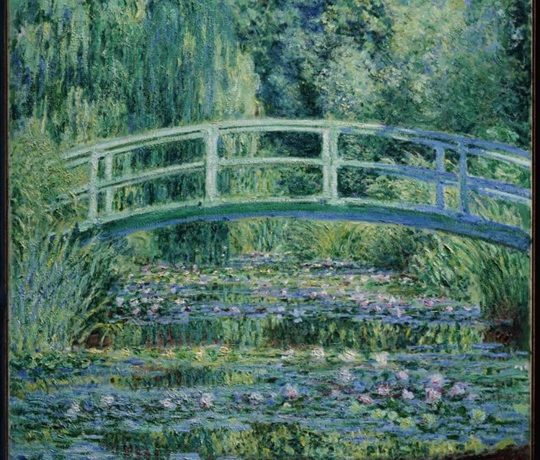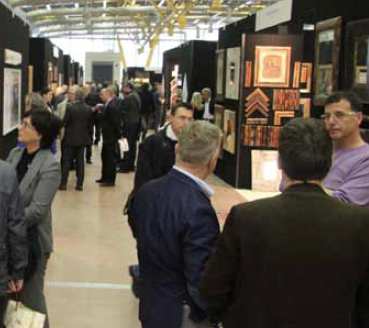Get the most out of your trade-show experience.
Despite today’s fast-paced world of social-media marketing and networking, there’s still no substitute for meeting customers and prospects in person. And there are few better places to accomplish just this goal than at a trade show.
According to Diane Attesi, who has managed trade shows for 13 years and currently works as director of trade shows and events at Wave Systems Corp., the primary reason to exhibit at a trade show is to increase sales and expand awareness of a company, a product or a brand.
Daniel Giglio of Exhibit & Tradeshow Consultants (exhibitandtradeshow.com) echoes these sentiments and notes that trade shows are still the most cost-effective ways to showcase products or services. “For example, if you received 100 leads at a show,” says Giglio, “what would it cost you to meet with these 100 potentials face-to-face?”
Sales are vital for any business, including an art business. At a trade show, exhibitors get the chance not only to showcase their products or services but also to meet with clients, gallery owners, journalists and other art professionals. The shows enable artists to gain important feedback on their work and see what others in the industry are doing.
But deciding whether and where to exhibit is just the first step. The second is making the most of those few show days available. Even the most seasoned exhibitors can make mistakes. Here are some tips to make sure you get the most out of your trade-show experience.
Do your homework beforehand.
Start planning for the show in advance. Note all deadlines and communicate with show managers and show service vendors, who can be helpful in explaining rules and answering questions. Attesi suggests assigning one person to oversee this process. Giglio advises early planning, including selecting booth spaces, booth design, graphics and construction. It will “help keep costs under control and will also help keep you from lastminute craziness and exhaustion,” he says.
Make your booth space open and inviting.
“Product is king!” says Peter LoCascio, who has been helping companies market themselves for more than 35 years and today runs Trade Show Consultants (tradeshowconsultants.com). “The exhibit booth should be designed to transform suspects who walk the aisles of a trade show into prospects.” This advice means that exhibitors must pay close attention to the layout. For example, they must leave plenty of open space for visitors and be sure that the lighting highlights the art on display.
“Lighting is critical for artworks,” says LoCascio. “The exhibitor should design his or her exhibit utilizing as much illumination as possible on each of the pieces displayed.”
Attesi adds that overstaffing or understaffing a booth can create an unfriendly layout. “You need two people for every 10×10[-foot] space, plus some extra staff to rotate in so everyone gets a break,” she says.
Consider your booth a store, too.
Use a trade show not only to exhibit your latest artworks but also to promote and sell other facets of your business, such as prints, calendars and cards.
Build contacts and mailing lists.
Social-media websites make it easy to build a following, but trade shows offer the opportunity to make a personal connection with those who admire your work and may be future clients. “Sales-lead management is also key to maintaining contact with booth visitors and should be a major focus,” says Lo- Cascio. “Get visitors’ names, addresses, cell phone [numbers] and e-mail addresses with a synopsis of discussion topics in a form that allows effective post-show communications.”
Promote your events.
Use the time you have at a trade show to promote other events in which you will be participating. Consider printing a list of upcoming shows or workshops, dates and locations for visitors to take with them.
Consider show specials and reduced show prices.
Show specials may help stimulate prospects that might seem to be wavering on price, says LoCascio. He suggests marking each piece with the regular price and the new special price. “The show special should be advertised in the booth and only last until one week after the show before the prices on selected items goes back up,” says LoCascio.
Stand up straight and smile.
Personal presentation at a trade show is important. Never leave your booth unattended, and those tending the booth should not just sit or “look uninterested,” says Giglio. “Always greet and make eye contact with passersby; you never know who is walking by your booth.”
“I see more 10×10 table shows where exhibitors put the table in the front and sit behind it and then check their e-mail,” says Attesi. “This does not send the message, ‘Welcome. Come into my exhibit. Relax, look around, have a seat, and learn more about our products!’ Walking up to an exhibit where the staff is checking their phones or in a circle chatting to each other can be intimidating for attendees and is the best way you could sabotage your investment.”
LoCascio also advises against exhibitors’ eating in the booths. It “deters visitors who don’t want to impose,” he says.









Kamla Ravikumar
11 November
Carrying Framed works across cities and countries can be very expensive and laborious for an artist.What is the best way and artist can exhibit carrying rolls of canvas across countries?Are there any instant rental frames available which can stretch canvases for exhibitions?